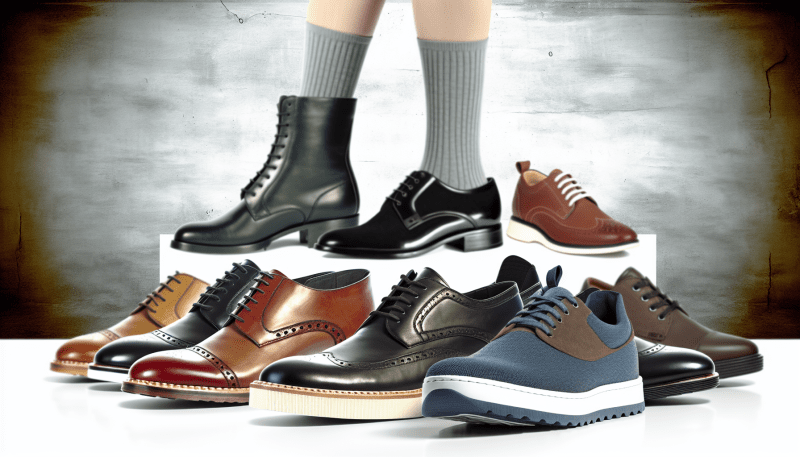When it comes to choosing the right style of dress shoes, there are several factors to consider that can significantly affect your overall look and comfort. First, think about the occasion. Are you dressing for a formal event, a business meeting, or a casual gathering? Each setting has its own set of expectations, and matching your shoe style to the occasion is key to making a great impression.
Next, consider the type of outfit you’ll be wearing. For example, classic oxfords tend to be a fantastic match for suits, while loafers can complement both slacks and dressy casual attire. Chelseas or brogues offer versatility, allowing you to pair them with chinos or tailored shorts for a polished look. Understanding how different styles interact with your wardrobe can help you make the best choice.
Fit is another critical aspect to keep in mind. The right fit not only enhances style but also ensures comfort, especially if you’ll be on your feet for extended periods. Be sure to try on shoes later in the day when your feet are slightly swollen to get an accurate sense of fit. This way, you can avoid the discomfort of a shoe that feels perfect in the morning but becomes unbearable by noon.
Finally, don’t forget to think about material and color. Leather is a popular choice for its durability and classic appeal, while suede can add a more relaxed vibe. For color, black is often seen as the go-to for formal wear, but don’t shy away from browns, burgundies, or even blues to give your outfit a personal touch. By considering these factors, you can find the dress shoe style that’s perfect for you.
Understanding Different Shoe Materials
When it comes to selecting the perfect dress shoes, understanding the different materials used can make a significant difference in both comfort and style. The most common materials are leather, suede, and synthetic options, each offering unique characteristics that cater to various needs and preferences.
Leather is perhaps the most classic choice for dress shoes. It's not only durable but also develops a beautiful patina over time, adding character to the shoes. There are several types of leather, including full-grain, top-grain, and corrected-grain, each offering varying levels of quality and price. Full-grain leather is the highest quality, known for its natural look and breathability. While it may require some care, it ensures longevity and comfort, making it a worthy investment for your wardrobe.
Suede, on the other hand, offers a more relaxed yet sophisticated appearance. Made from the inner layer of the animal hide, suede is softer and has a unique texture that can elevate your outfit. However, it is more prone to stains and water damage, so it's essential to treat suede shoes with a protective spray. Suede shoes work well for semi-formal occasions and pair nicely with chinos or lighter fabrics.
Synthetic materials have gained popularity in recent years due to their affordability and ease of maintenance. While they may not offer the same level of breathability or durability as leather or suede, modern synthetics can closely mimic the look of traditional materials. They are often lighter and more resistant to spills, making them a practical option for everyday wear.
Ultimately, the best shoe material for you depends on your personal style, lifestyle, and the occasions you wear them for. Each material has its pros and cons, so understanding these differences will help you make a more informed decision when selecting your dress shoes.
Finding Your Perfect Fit
When it comes to dress shoes, finding the perfect fit is essential for both comfort and style. A well-fitted shoe not only enhances your appearance but also protects your feet from discomfort and injury. Start by measuring your feet accurately. It’s best to measure them at the end of the day when they are slightly swollen, as this will give you the most accurate size. Don’t forget to measure both feet, as it’s common for one foot to be larger than the other. When shopping for shoes, always try on both pairs and walk around to ensure they feel just right.
Next, consider the shoe width. Dress shoes often come in various widths, including narrow, medium, and wide. If you have wider feet, look for brands that offer wide sizing options. A shoe that is too tight can cause blisters and discomfort, while one that is too loose can lead to instability. Make sure there is enough room in the toe box for your toes to wiggle comfortably, and check that the heel doesn’t slip as you walk.
It’s also crucial to pay attention to the arch support in your shoes. Individuals with high arches may require more cushioning, while those with flat feet might need a firmer base. Some brands may offer shoes with built-in arch support, while others allow you to add custom insoles tailored to your needs. Take the time to test the shoes on different surfaces to evaluate their comfort level before making your final decision.
Lastly, keep in mind the style and purpose of your dress shoes. Whether you’re looking for something for the office, a formal event, or a casual outing, the right fit can elevate your entire look. Take your time to explore different styles, such as oxfords, loafers, or brogues, and don’t hesitate to consult a salesperson for guidance. The right dress shoe will not only fit you perfectly but will also complement your wardrobe effortlessly.
Caring for Your Dress Shoes
Next, regular cleaning is crucial. Use a soft brush or cloth to remove dirt and dust after each wear. For scuff marks, a little bit of polish can work wonders. Choose a high-quality cream or wax polish that matches your shoe color. Apply it with a soft cloth, working it into the leather in circular motions, and don’t forget to buff it afterward for a shiny finish.
Moisture can be the enemy of dress shoes. If your shoes get wet, never place them near direct heat sources like radiators, as this can cause the leather to crack. Instead, let them air dry naturally. You can stuff them with newspaper to help absorb excess moisture and maintain their shape while they dry.
Lastly, remember that rotation is key. Wearing the same pair of dress shoes every day can lead to quicker wear and tear. Try to have at least two pairs that you can rotate, giving each pair time to rest between wears. This practice will not only prolong the lifespan of your shoes but also keep them looking sharp and ready for any occasion.



